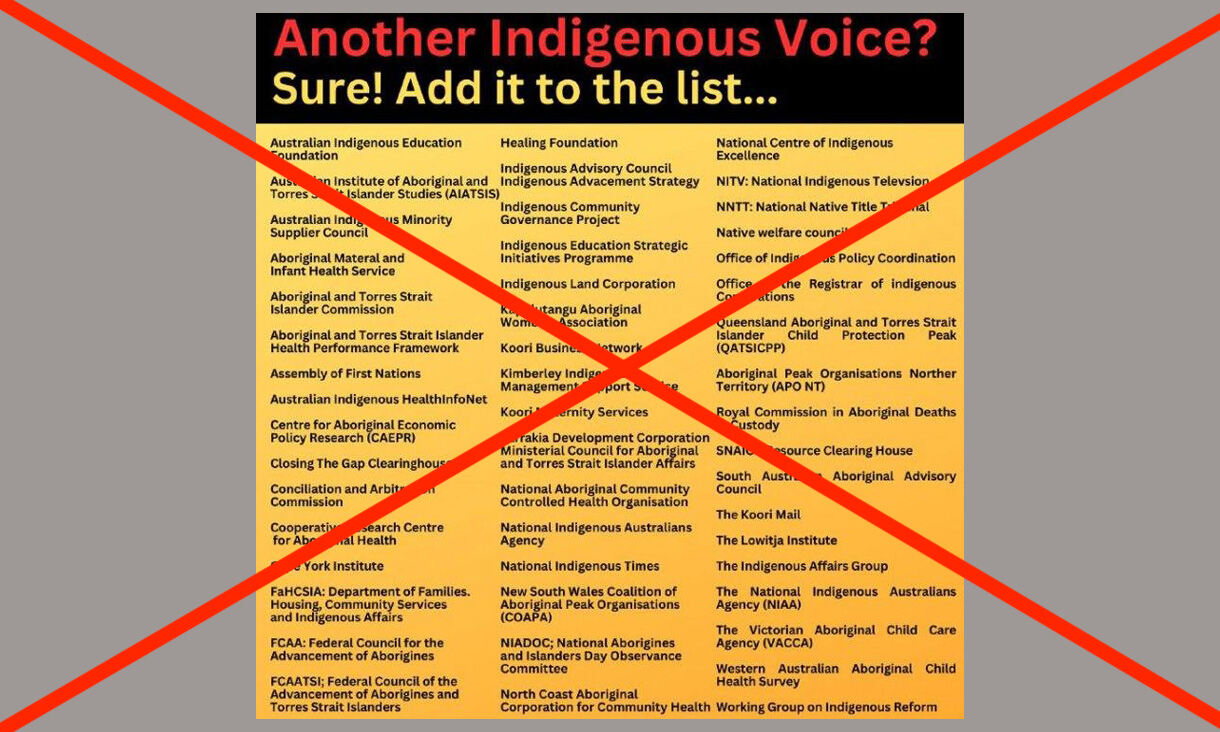
Zombie claims: Bogus list of Voice groups is back from the dead
What was claimed |
The verdict |
Indigenous Australians already have 51 organisations that fulfil the role of a Voice to Parliament so a constitutionally enshrined Voice is not necessary. |
False. A list of 51 entities includes defunct groups, not-for-profits and a Canadian organisation. None on the list are comparable to the proposed Aboriginal and Torres Strait Islander Voice. |
By Eiddwen Jeffery
Zombies not only exist in movies but also populate social media in the form of misleading information that, once shared online, keeps mutating and resurfacing – even after it has been killed off by fact checkers.
This has been the case in the lead up to the Aboriginal and Torres Strait Islander Voice referendum, with false claims continuing to return from the dead despite fact checks setting the record straight.
One such “zombie claim” is a list of 51 entities that supposedly already give Indigenous Australians a voice in parliament, making the upcoming referendum unnecessary. The list has been shared online in the push for a No vote.
But the list is bogus. More than a third of the organisations are either defunct, appear multiple times on the list or are unrelated to governments. And importantly, none fulfils the role of the proposed Voice to Parliament, according to constitutional law experts.

RMIT FactLab’s weekly newsletter, CheckMate reported on the list in March, but since then the zombie claim has continued to resurface, with a recent spate of shares in June.
More than 10 on the list never existed or are now defunct, including the Federal Council for the Advancement of Aborigines and Torres Strait Islanders, which was abolished in 1978.
Other entries are standalone government projects or reports, such as the Closing the Gap Clearinghouse, which ran from 2009 to 2014, or the 1987 Royal Commission into Aboriginal Deaths in Custody.
The government agency responsible for policy development for Indigenous Australians, the National Indigenous Australians Agency makes an appearance twice. While a national body representing Aboriginal interests that was disbanded in 1978 is listed twice as the Federal Council for Aboriginal Advancement (FCAA) and the Federal Council for the Advancement of Aborigines and Torres Strait Islanders (FCAATSI).
Eight of the listed entities are health related, including peak body the National Aboriginal Community Controlled Health Organisation, and a Victorian initiative for Aboriginal mothers, the Koori Maternity Services.
There are also several non-government bodies listed including two media organisations and the government free-to-air channel NITV and also a not-for-profit, dedicated to supporting survivors of the stolen generation.
The list also cites the Assembly of First Nations, which is a Canadian national advocacy organisation.
The image of the list, which has a headline: “Another Indigenous Voice? Sure! Add it to the list…”, has been used by sharers of the post to suggest that Indigenous Australians already have many organisations that fulfil the role of a Voice to Parliament.
“WE DO NOT NEED ANOTHER VOICE TO PARLIAMENT, THEY ARE OVER REPRESENTED NOW !!!!!” one Facebook user wrote on their post next to an image of the list.
But none of the organisations on the list are comparable to the proposed Aboriginal and Torres Strait Islander Voice, which would be an advisory body that could make representations to government and parliament regarding policy affecting Indigenous Australians.
FactLab confirmed this with multiple constitutional law experts in a fact check published in April, addressing a longer version of the list.
Professor Gabrielle Appleby of the Law Faculty at the University of New South Wales told Factlab in April that the proposed Voice would perform a distinct role that was currently lacking in the Australian system.
“The Voice will fill an important gap in Australia’s constitutional and governance system,” she said. “There is currently no national representative body that is selected by and accountable back to Aboriginal and Torres Strait Islander people, with the specific role of providing advice to the national government and parliament in relation to making decisions, developing policies and laws, relating to Aboriginal and Torres Strait Islander people.
“Not one of the existing government – or private – agencies or organisations fulfils this role,” she said, adding that the list published online was a “grab-bag” of organisations that related to Aboriginal and Torres Strait Islander people.
Luke Beck, Professor of Constitutional Law at Monash University, agreed that the proposed Voice differed from existing organisations and agencies in terms of its power and advisory functions.
“A constitutionally entrenched Voice to Parliament is a very different thing to the various advisory committees that exist within particular government departments and agencies and also a very different thing to various Aboriginal community-controlled organisations that engage in advocacy,” Professor Beck said via email.
As debate heats up on the referendum, RMIT FactLab has debunked dozens of false claims relating to the Voice, including a number of zombie claims. One recent fact check was a resurfaced list of 31 purported proposals claiming to expose the “real agenda behind the voice”.
Australia will vote on the Aboriginal and Torres Strait Islander Voice in a referendum, to be held sometime between October and December of this year.
The verdictFalse. The list is a hybrid mix of government bodies, private organisations and defunct groups. None of the listed organisations fulfils the role of the proposed Indigenous Voice to Parliament, according to constitutional law experts.
|


Acknowledgement of Country
RMIT University acknowledges the people of the Woi wurrung and Boon wurrung language groups of the eastern Kulin Nation on whose unceded lands we conduct the business of the University. RMIT University respectfully acknowledges their Ancestors and Elders, past and present. RMIT also acknowledges the Traditional Custodians and their Ancestors of the lands and waters across Australia where we conduct our business - Artwork 'Sentient' by Hollie Johnson, Gunaikurnai and Monero Ngarigo.
More information